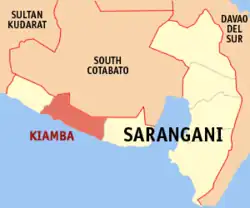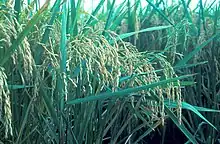Kiamba, Sarangani
Kiamba, officially the Municipality of Kiamba (Cebuano: Lungsod sa Kiamba; Maguindanaon: Inged nu Kiamba, Jawi: ايڠد نو كيامب; Tagalog: Bayan ng Kiamba), is a 1st class municipality in the province of Sarangani, Philippines. According to the 2020 census, it has a population of 65,774 people.[3]
Kiamba | |
|---|---|
| Municipality of Kiamba | |
| Other transcription(s) | |
 Tuka Beach | |
 Flag  Seal | |
 Map of Sarangani with Kiamba highlighted | |
OpenStreetMap | |
.svg.png.webp) Kiamba Location within the Philippines | |
| Coordinates: 5°59′N 124°37′E | |
| Country | Philippines |
| Region | Soccsksargen |
| Province | Sarangani |
| District | Lone district |
| Founded | August 18, 1947 |
| Barangays | 19 (see Barangays) |
| Government | |
| • Type | Sangguniang Bayan |
| • Mayor | George F. Falgui |
| • Vice Mayor | Marie Jess M. Ancheta |
| • Representative | Steve Solon |
| • Municipal Council | Members |
| • Electorate | 39,991 voters (2022) |
| Area | |
| • Total | 328.68 km2 (126.90 sq mi) |
| Elevation | 73 m (240 ft) |
| Highest elevation | 661 m (2,169 ft) |
| Lowest elevation | 0 m (0 ft) |
| Population (2020 census)[3] | |
| • Total | 65,774 |
| • Density | 200/km2 (520/sq mi) |
| • Households | 15,420 |
| Economy | |
| • Income class | 1st municipal income class |
| • Poverty incidence | 33.40 |
| • Revenue | ₱ 239.3 million (2020) |
| • Assets | ₱ 425.8 million (2020) |
| • Expenditure | ₱ 201.7 million (2020) |
| • Liabilities | ₱ 144.5 million (2020) |
| Service provider | |
| • Electricity | South Cotabato 2 Electric Cooperative (SOCOTECO 2) |
| Time zone | UTC+8 (PST) |
| ZIP code | 9514 |
| PSGC | |
| IDD : area code | +63 (0)83 |
| Native languages | Cebuano Tboli Maguindanao Blaan Tagalog |
| Website | kiamba |
It is bordered on the west by Maitum, on the east by Maasim, on the north by South Cotabato, and on the south by the Celebes Sea.
Notable residents include Manny Pacquiao. It is the hometown of his wife Jinkee Pacquiao.[5][6][7]
History
The area of what is now known as MAKIMA was first inhabited by T'boli tribes people who mostly occupied the highlands. The lowlands and plains were mostly occupied by Maguindanaons especially Sultanate of Maguindanao then Sultanate of Buayan and the Sangil people who mostly are from Balut and Sangili islands, occupied the areas near the sea. The Ilocanos who are originally from Luzon only came to the area around 1920's onwards as they heed the government's homesteading and resettlement plan. Visayans later followed.
The municipality was formed on August 18, 1947, when Executive Order No. 82 was signed by the government by merging the municipal districts of Kraan and Kling.
Maitum on the west became an independent municipality in 1959. In 1971, Maasim, on the east, also became an independent municipality.[8]
Geography
Barangays
Kiamba is politically subdivided into 19 barangays. Each barangay consists of puroks while some have sitios.
- Badtasan
- Datu Dani
- Gasi
- Kapate
- Katubao
- Kayupo
- Kling (Lumit)
- Lagundi
- Lebe
- Lomuyon
- Luma
- Maligang
- Nalus
- Poblacion
- Salakit
- Suli
- Tablao
- Tamadang
- Tambilil
Climate
| Climate data for Kiamba, Sarangani | |||||||||||||
|---|---|---|---|---|---|---|---|---|---|---|---|---|---|
| Month | Jan | Feb | Mar | Apr | May | Jun | Jul | Aug | Sep | Oct | Nov | Dec | Year |
| Average high °C (°F) | 30 (86) |
30 (86) |
31 (88) |
31 (88) |
30 (86) |
29 (84) |
29 (84) |
29 (84) |
30 (86) |
30 (86) |
29 (84) |
30 (86) |
30 (86) |
| Average low °C (°F) | 23 (73) |
23 (73) |
24 (75) |
24 (75) |
25 (77) |
24 (75) |
24 (75) |
24 (75) |
24 (75) |
24 (75) |
24 (75) |
24 (75) |
24 (75) |
| Average precipitation mm (inches) | 193 (7.6) |
177 (7.0) |
222 (8.7) |
222 (8.7) |
278 (10.9) |
292 (11.5) |
245 (9.6) |
222 (8.7) |
174 (6.9) |
193 (7.6) |
245 (9.6) |
233 (9.2) |
2,696 (106) |
| Average rainy days | 24.6 | 22.1 | 25.7 | 26.3 | 28.4 | 27.2 | 25.9 | 25.2 | 22.3 | 25.9 | 27.3 | 26.9 | 307.8 |
| Source: Meteoblue[9] | |||||||||||||
Demographics
| Year | Pop. | ±% p.a. |
|---|---|---|
| 1918 | 12,734 | — |
| 1939 | 14,687 | +0.68% |
| 1948 | 15,824 | +0.83% |
| 1960 | 32,358 | +6.14% |
| 1970 | 21,424 | −4.03% |
| 1975 | 21,986 | +0.52% |
| 1980 | 28,467 | +5.30% |
| 1990 | 35,418 | +2.21% |
| 1995 | 39,717 | +2.17% |
| 2000 | 44,724 | +2.58% |
| 2007 | 53,040 | +2.38% |
| 2010 | 54,871 | +1.24% |
| 2015 | 61,058 | +2.06% |
| 2020 | 65,774 | +1.47% |
| Source: Philippine Statistics Authority[10][11][12][13] | ||
The majority of the population speak Cebuano, although early settlers were of Ilocano origin, as a result of assimilation into the majority Cebuano-speaking society due to the huge influx of migrants from Cebu, Bohol, Siquijor, and other Cebuano-speaking parts of Mindanao residing in the area over the years. There are a lot of Moro people (Sangil and Maguindanaon) who settles in the area long before the Christians from Luzon (and later Visayas) came. One of the indigenous peoples living in mountainous areas of Kiamba is known as T'boli.
Economy


The economy of Kiamba is largely based on agriculture with vast ricefields surrounding the municipality. Aqua-culture is the second biggest income earner, notably the culture of milkfish and shrimps (locally called "sugpo" or "lukon") for export. Also, coastal communities depend on deep-sea fishing as a primary livelihood.
Tourism
The Timpuyog festival celebrates the town's foundation anniversary. Timpuyog is an Ilocano word for unity, and the festival includes tribal shows and carnaval. Kiamba celebrate their Timpuyog Festival and Foundation Anniversary every February 14.
Visitors attractions include:
- Waterfalls in lush rainforests (ex. Nalus Falls)
- Short, narrow roads lined with Japanese era houses
- Cockfights
- Tuka Marine Park, a protected area where fishing is banned. It has four protected coves and only one (Tuka 2) is open to the public. The site has coral formations.
- Beaches of Kiamba (ex. Wakap Beach in Datu Dani)
- Kiamba Philippines was mentioned in the Uncharted movie.
Education
- Kiamba National High School
- Notre Dame of Kiamba
- Southern Cotabato Academy
- J.B.T. Caing Sr. Memorial Integrated School
- James L. Chiongbian National Trade School (Formerly Kling National High school)
- Cabales-Enarbia Integrated School
- Salakit National High School
- Goldenstate College of Kiamba
- Euro Asia College of Technology Incorporated
Media
FM Stations
- 88.9 DABIG C Radio (Prime Broadcasting Network)
- 100.5 Muews Radio (Sagay Broadcasting Corporation)
- 101.3 Radyo Natin (Manila Broadcasting Company/Radyo Natin Network)
- 104.9 Brigada News FM (Brigada Mass Media Corporation)
Cable and Satellite TV
- Kiamba Cable TV Service Cooperative
- Sarangani Cable Corporation
References
- Municipality of Kiamba | (DILG)
- "2015 Census of Population, Report No. 3 – Population, Land Area, and Population Density" (PDF). Philippine Statistics Authority. Quezon City, Philippines. August 2016. ISSN 0117-1453. Archived (PDF) from the original on May 25, 2021. Retrieved July 16, 2021.
- Census of Population (2020). "Region XII (Soccsksargen)". Total Population by Province, City, Municipality and Barangay. Philippine Statistics Authority. Retrieved 8 July 2021.
- "PSA Releases the 2018 Municipal and City Level Poverty Estimates". Philippine Statistics Authority. 15 December 2021. Retrieved 22 January 2022.
- "Pacquiao builds house in Sarangani | balita.ph". Archived from the original on October 5, 2011.
- "Home". Philippine Information Agency.
- "Pacquiao to run for House seat - INQUIRER.net, Philippine News for Filipinos". Philippine Daily Inquirer. Archived from the original on February 9, 2009. Retrieved May 9, 2009.
- "Kiamba Municipality was Born". Local Government of Kiamba. Retrieved April 11, 2017.
- "Kiamba: Average Temperatures and Rainfall". Meteoblue. Retrieved May 15, 2020.
- Census of Population (2015). "Region XII (Soccsksargen)". Total Population by Province, City, Municipality and Barangay. Philippine Statistics Authority. Retrieved 20 June 2016.
- Census of Population and Housing (2010). "Region XII (Soccsksargen)". Total Population by Province, City, Municipality and Barangay. National Statistics Office. Retrieved 29 June 2016.
- Censuses of Population (1903–2007). "Region XII (Soccsksargen)". Table 1. Population Enumerated in Various Censuses by Province/Highly Urbanized City: 1903 to 2007. National Statistics Office.
- "Province of Sarangani". Municipality Population Data. Local Water Utilities Administration Research Division. Retrieved 17 December 2016.
- "Poverty incidence (PI):". Philippine Statistics Authority. Retrieved December 28, 2020.
- "Estimation of Local Poverty in the Philippines" (PDF). Philippine Statistics Authority. 29 November 2005.
- "2003 City and Municipal Level Poverty Estimates" (PDF). Philippine Statistics Authority. 23 March 2009.
- "City and Municipal Level Poverty Estimates; 2006 and 2009" (PDF). Philippine Statistics Authority. 3 August 2012.
- "2012 Municipal and City Level Poverty Estimates" (PDF). Philippine Statistics Authority. 31 May 2016.
- "Municipal and City Level Small Area Poverty Estimates; 2009, 2012 and 2015". Philippine Statistics Authority. 10 July 2019.
- "PSA Releases the 2018 Municipal and City Level Poverty Estimates". Philippine Statistics Authority. 15 December 2021. Retrieved 22 January 2022.
External links
- Kiamba Profile at PhilAtlas.com
- Kiamba Profile at the DTI Cities and Municipalities Competitive Index
- Kiamba Municipal Profile at the Province of Sarangani Official Website
- Official website
- Philippine Standard Geographic Code
- Philippine Census Information
- Local Governance Performance Management System Archived 2016-03-04 at the Wayback Machine